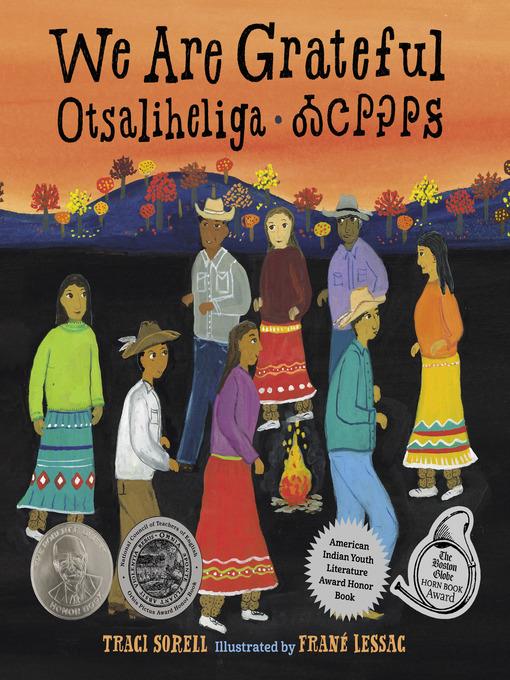
We Are Grateful
Otsaliheliga
فرمت کتاب
ebook
تاریخ انتشار
2018
Lexile Score
970
Reading Level
0-2
ATOS
3
Interest Level
K-3(LG)
نویسنده
Frane Lessacناشر
Charlesbridgeشابک
9781632896339
کتاب های مرتبط
- اطلاعات
- نقد و بررسی
- دیدگاه کاربران
نقد و بررسی

July 1, 2018
K-Gr 2-Sorell, a citizen of the Cherokee Nation, offers readers a look at contemporary Cherokee life as she follows a family through the seasons of the year as they take part in ceremonies and festivals. The book opens, "Cherokee people say otsaliheliga to express gratitude. It is a reminder to celebrate our blessings and reflect on struggles-daily, throughout the year...." Beginning in the fall (uligohvsdi) with the Cherokee New Year, a variety of rituals and cultural symbols are introduced, all in spare, lyrical, accessible language. Traditional foods, crafts, and songs are part of the engaging narrative, as is the refrain, "we say otsaliheliga." Once through the calendar, Sorell circles back to the Cherokee National Holiday (Labor Day weekend), "when we recall the ancestors' sacrifices to preserve our way of life.... to celebrate nulistanidolv, history, and listen to our tribal leaders speak." Cherokee words are presented both phonetically and written in the Cherokee syllabary. Lessac's lovely gouache folk-art style paintings bring the scenes to life. Back matter includes a description of the various ceremonies, notes, and a page devoted to the Cherokee syllabary. VERDICT This informative and authentic introduction to a thriving ancestral and ceremonial way of life is perfect for holiday and family sharing.-Luann Toth, School Library Journal
Copyright 2018 School Library Journal, LLC Used with permission.

July 15, 2018
According to storyteller Sorell, the Cherokee people always express gratitude for the little things they are given by saying the phrase, "Otsaliheliga," or "we are grateful." Raised in the Cherokee Nation, Sorell intentionally crafts a narrative that simultaneously embraces modernity and a traditional presentation of Cherokee community and way of life. Throughout, the measured text reminds readers that in all things "we say otsaliheliga." Colorful, folk art-style illustrations show Cherokee people during ceremonies, in family gatherings large and small, and outdoors enjoying each of the four seasons, always expressing gratitude. The scenes are contemporary; one shows a father taking care of his children, engaging in a positive parenting role, while another depicts a family seeing off a relative who is leaving for deployment in the military, underscoring that Cherokee people serve their country. Children participate in rites and in family outings with adults, and they also play traditional games such as stickball and plant strawberries, a practice that reminds their people to embrace peace with one another. The variety of skin tones represented in the illustrations likewise depicts a present-day reflection of the diversity that exists within the Cherokee people. Occasional Cherokee words are written in Romanized form, phonetically, in Cherokee characters, and in English--a lovely grace note. A gracious, warm, and loving celebration of community and gratitude. (glossary, author's note, Cherokee syllabary) (Picture book. 4-8)
COPYRIGHT(2018) Kirkus Reviews, ALL RIGHTS RESERVED.

September 15, 2018
Grades 1-3 In Cherokee culture, Sorell shares, the expression of gratitude is part of daily life and extends from elaborate celebrations to struggles to ordinary life moments. She organizes her debut picture book by seasons, beginning with the fall, which is a time for collecting foliage for basket making and remembering those who suffered on the Trail of Tears. It also contains the Cherokee New Year and the Great New Moon Ceremony, a celebration of renewal and coming together. Each season section starts with the name of the season in Cherokee, an expression of gratitude for the change in nature, and subsequent pages describing community activities pertinent to that season. Lessac's folkloric illustrations in bright gouache colors stand in pleasing contrast to the book's contemporary feel and setting. The text reads like poetry but has a gentle instructional dimension to it. On many pages, Cherokee words are accompanied by English translations, pronunciation guides, and Cherokee syllabary. Back matter contains relevant explanations and provides good context, and the author's note sets past misrepresentations right.(Reprinted with permission of Booklist, copyright 2018, American Library Association.)

























دیدگاه کاربران